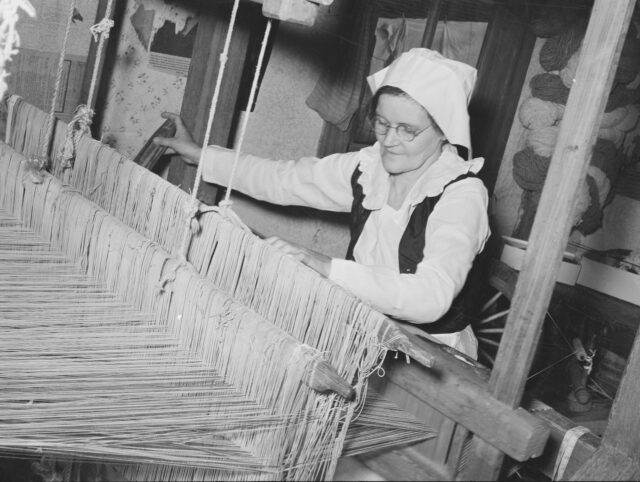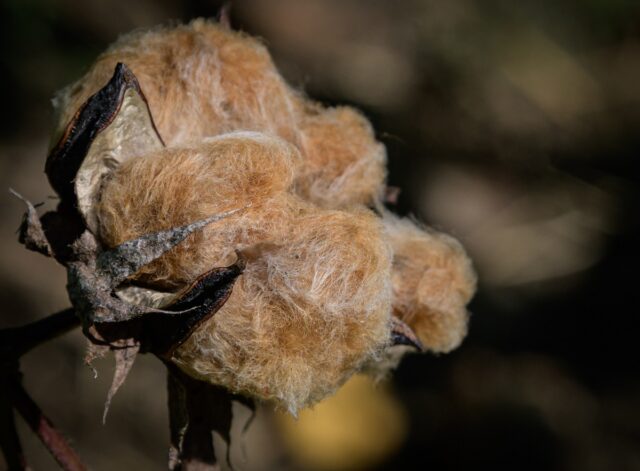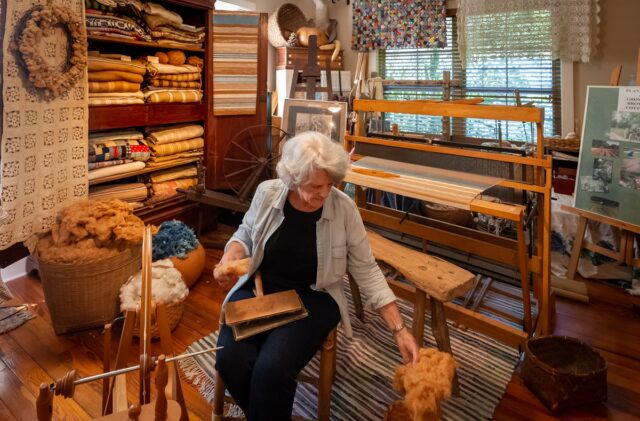Acadian Brown Cotton
The fabric of Acadiana
Published: September 1, 2020
Last Updated: March 22, 2023
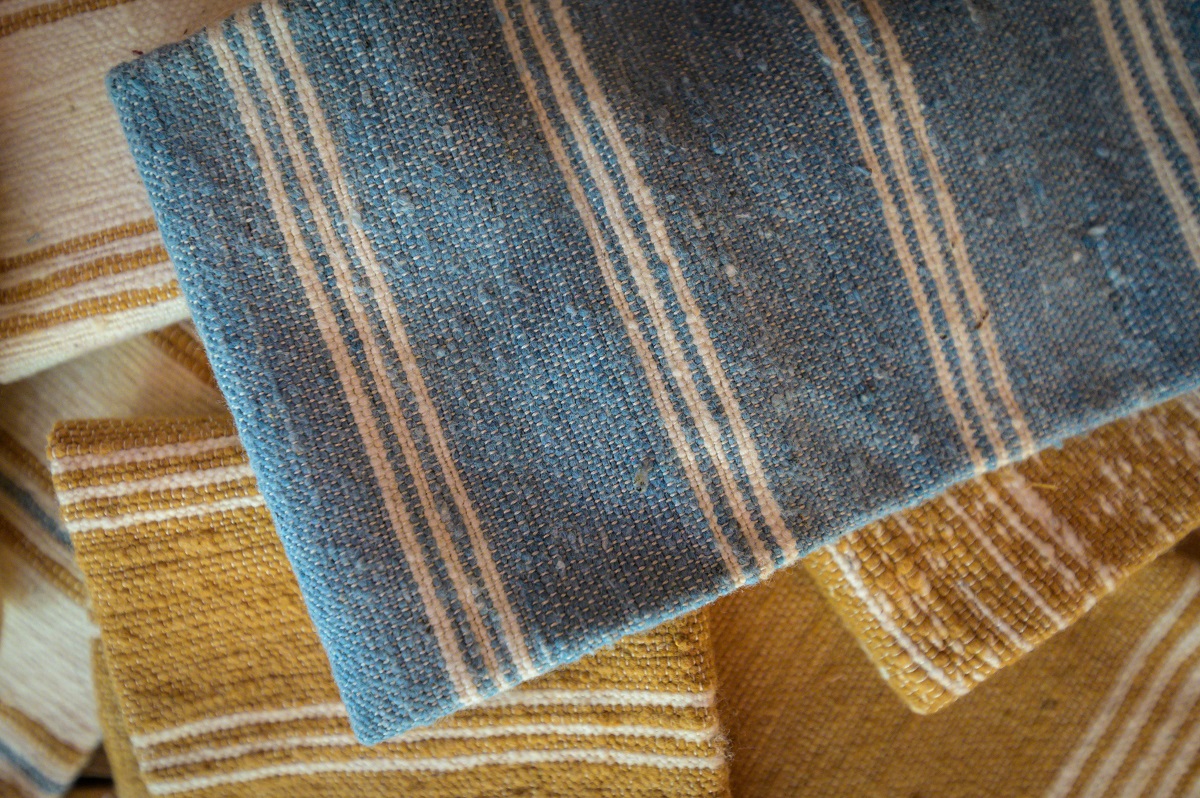
Finished goods made from Acadian brown cotton.
Photo by James Edmunds
The story of Acadian brown cotton began more than two hundred years ago, when the Acadians were exiled from Nova Scotia and made their way to southwestern Louisiana. In this sense it is a classic American tale rooted in immigration and the hardships that starting a new life in a strange land entail. Most are familiar with parts of this story, about those early Acadians’ ingenuity and perseverance, how hard they must have worked to survive in such an alien and unforgiving climate. However, many may be unfamiliar with the history of the Acadian brown cotton tradition, which is also a story about women. Cultural values were instilled in Acadian children by their mothers and grandmothers. Even the brown cotton seed itself was traditionally passed from mother to daughter.
There are thousands of Acadian weavers whose names and textiles have not survived, but the information that has been preserved is a credit to the efforts of a succession of women. In the late nineteenth century, Sara Avery Leeds and Margaret Avery Johnston, members of the McIlhenny family, creators of the famed Tabasco Pepper Sauce, played an important role. They facilitated the sale of Acadian handicrafts in New Orleans through the Christian Women’s Exchange and took weavers to the 1893 World’s Columbian Exposition in Chicago to showcase Acadian culture.
Perhaps the most influential woman in the continuum of the Acadian brown cotton tradition was Louise Olivier, Director of the Acadian Handicraft Project from 1942 to 1962, and likely the most prolific Acadian cultural activist of the twentieth century. Olivier realized that the most effective channel to perpetuate the preservation of Acadian culture was to broadly market Acadian handicrafts as valuable commodities. She enlisted traditional Acadian weavers, quilters, seamstresses, and palmetto braiders to produce items for sale and exhibition at public libraries, meetings, and festivals. The most prominent weaver who worked for Olivier was Gladys LeBlanc Clark, who grew up surrounded by the tradition; her mother, aunt, paternal grandmother, and maternal great-grandmother all grew and wove Acadian brown cotton, and Clark and other members of her family were invited to participate in the Acadian Handicraft Project in the 1940s. Clark learned to card and spin brown cotton at the age of eight and never stopped. She recalled with fondness the tradition of la cardie (a carding party). Sometimes also called écarderies, these were parties where family, friends, and neighbors would gather, each bringing her own chair and carding tools, to sit together carding cotton for hours, enjoying each other’s company.
Although the Acadian Handicraft Project was dismantled after Olivier’s death in 1962, Clark continued working to preserve Acadian culture, particularly its brown cotton textile tradition, for the next four decades. She spent a great deal of time demonstrating spinning and weaving all over the country, including at the Smithsonian Festival of American Folklife in Washington, DC. She taught her craft to her apprentice and dear friend, Elaine Larcade Bourque, who is now widely considered the greatest living Acadian spinner and weaver. When Clark was invited to the White House in 1997 to receive a National Heritage Fellowship from the National Endowment for the Arts, she insisted Bourque accompany her. As they stood next to then First Lady Hillary Clinton, cameras snapping, Clark leaned over and whispered in Bourque’s ear, “I wish my mother could see me now.”
By the mid-1930s, around the time Clark came of age, the advances made possible by running water and electricity were improving and changing the way many Americans lived and worked. However, large swaths of America lagged behind. Electrification would not come to Acadiana until the 1950s because, as in other rural, largely agrarian parts of the United States, power companies refused to build lines connecting the tens of thousands of miles between individual farms and ranches.
This meant that even in the twentieth century, subsistence-level farmers and their families were executing everyday household and farm chores by hand, from milking the cows to cutting the hay and planting and harvesting the crops. There was so much to be done—every hour counted—and the work did not stop when the sun set. After a long day, the women and children undertook the hand-ginning, carding, spinning, and weaving of brown cotton, both using the techniques taught to them and teaching the next generation. The looms were so large that often the only place they could fit was in the hot, stuffy attic. For more than 175 years most Acadian weavers worked by the dim light of homemade tallow candles or kerosene lanterns, producing blankets, sheets, and bolts of cloth that would be made into clothing.
Eventually modernity reached even the most isolated Acadian homesteads. But even as commercially woven fabric became a staple, Acadian mothers continued to weave the traditional dowry for Cajun brides, a set of textiles referred to in French as L’Amour de Maman—a mother’s love. While the custom varied by location and evolved over time, the oral tradition indicates that L’Amour de Maman typically consisted of twelve blankets, twelve bedspreads or coverlets, six sheets, twelve towels, four mattress covers, one bolster, two pillows, and sometimes a quilt. Both long-staple white cotton and shorter-staple natural brown cotton were used. This incredible gift provided a new bride with a near-lifetime supply of household textiles, enabling her to focus on production for the next generation.
It is easy to understand why isolated communities of subsistence-level farmers would be attracted to a cotton plant that could be hand-ginned for the creation of home textiles. The tradition of Acadian brown cotton seems to have developed for reasons beyond this obvious explanation, though; it is a tradition informed not only by logic but by culture. As anyone who has lived among them can attest, Acadians are fiercely independent. Absolute self-sufficiency isn’t just a point of pride but a bedrock cultural value. Using brown cotton meant Acadians could make cloth with no outside help. And brown cotton also offered another benefit: when spun or woven alongside white cotton, it afforded Acadian weavers another color with which to create their blankets’ now signature look.
But even these notions of cultural values and self-sufficiency do not tell the complete story of Acadian brown cotton. Researcher Dr. C. Ray Brassieur uses probate records to elaborate on the nature of brown cotton production as it relates to slavery in Acadiana. The sheer quantity of weaving equipment that passed from generation to generation among some Acadians makes it almost certain that brown cotton was used at a large scale to produce clothing for enslaved people. This can be deduced because Acadians were not bringing woven goods to market on a scale that matched the weaving infrastructure we know existed. An overall picture emerges when Carl Brasseaux’s research from The Founding of New Acadia, which posits slavery as a pervasive, small-scale cottage industry in Acadiana, is compared to accounts of enslaved weavers creating cottonade work clothes within the region. Some of these accounts can be found in the catalog for the 1983 exhibition L’Amour de Maman: The Acadian Textile Heritage produced by the Louisiana State Museum. Accounts such as these, and the probate records the team at the Hilliard are using, create a more complicated picture of how Acadians wove for their households, which included enslaved people. In reality, many Acadians participated in slavery at multiple scales. This contradicts the pervasive romantic notion of Acadians as exclusively subsistence-level farmers. Research is ongoing and further revelations may emerge.
Acadian blankets are beautiful, tactile objects. It feels as though they cry out to have their complicated past understood. This is typified in the way one of the key collaborators on the forthcoming exhibition at the Hilliard Art Museum became involved. Californian Sharon Gordon Donnan saw her first Acadian brown cotton blanket in 2011 while antique shopping with a friend in Washington, Louisiana. After many years of working on archaeological excavations in Northern Peru and pursuing research in the highlands of Oaxaca, Mexico, Donnan was well acquainted with natural brown cotton. But, despite her expertise, she was unaware of the existence of a textile tradition in Louisiana, much less one that involved the cultivation and use of brown cotton. The combination of a history worthy of preservation, visually stunning artifacts, and an abundance of Cajun storytellers anxious to recall their grandmère’s love and hard work drove Donnan to produce and co-direct, with Suzanne Chaillot Breaux, the documentary film Coton Jaune: Acadian Brown Cotton, a Cajun Love Story. Donnan credits her friend and collaborator Elaine Larcade Bourque as an invaluable resource.
The turnout for the 2015 premiere of Coton Jaune in Lafayette and New Orleans was record-breaking. There was immediate interest from the community about this nearly forgotten part of their culture. The outpouring of enthusiasm for and stories about Acadian brown cotton spurred Donnan on, and the following year she spearheaded the creation of the Field to Fashion in Acadiana project. Based in Acadiana, its mission is to preserve the heirloom Acadiana brown cotton seed through seed banking, a goal accomplished in relatively short order via a partnership with the Cade Research Farm at the University of Louisiana at Lafayette.
The project now has an ever-growing roster of farmers and significant partner organizations who are supporting their efforts to organically grow and create products with brown cotton on an increasing scale. Since the inception of Donnan’s Field to Fashion in Acadiana initiative in 2016, regional, national, and even international interest in purchasing the ginned brown cotton has grown exponentially. The hope is that the ethical production of brown cotton cloth could drive the development of new and sustainable industries in Acadiana.
In April, the National Endowment for the Humanities awarded the Hilliard Art Museum a $75,000 Public Humanities Projects grant in support of the exhibit Acadian Brown Cotton: The Fabric of Acadiana, which opens this fall. The Fabric of Acadiana will explore and celebrate Acadiana’s brown cotton tradition of more than 230 years, using maps and genealogical charts to ground visitors in the tradition’s history and show its slow geographic dispersal from France to Canada to Louisiana. The exhibition will also chart the tradition’s transition from necessity to craft, from craft to artistry, and from artistry to industry. Aside from blankets and maps, the exhibition will boast a wide variety of interpretive texts (many of which will be provided in both English and French, at the recommendation of the Council for the Development of French in Louisiana), soundscapes, video, photography, and archival documents that highlight the artistry of Acadian weavers and illustrate their continued relevance. The exhibit hopes to cast a new light on what many still view as simply the old brown blankets sitting in attics across Acadiana. Not only are they valuable, they are part of a fascinating history, as well as a burgeoning new industry.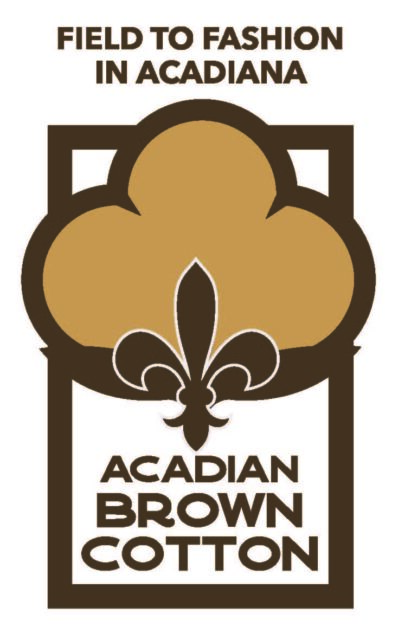 This fall, Acadian Brown Cotton: The Fabric of Acadiana will acknowledge the crucial role generations of Acadian women played in the creation and preservation of an important aspect of Louisiana’s vibrant culture. Additionally, the role of Acadian brown cotton within the context of slavery will be elucidated more clearly than ever before, and a complementary exhibition featuring the work of LaChaun Moore, an African American artist, weaver, and cotton farmer based in South Carolina will give a contemporary perspective to broader discussions about the culturally complex role cotton has played in American history. For more information on the exhibition and related programming, visit hilliardmuseum.org.
This fall, Acadian Brown Cotton: The Fabric of Acadiana will acknowledge the crucial role generations of Acadian women played in the creation and preservation of an important aspect of Louisiana’s vibrant culture. Additionally, the role of Acadian brown cotton within the context of slavery will be elucidated more clearly than ever before, and a complementary exhibition featuring the work of LaChaun Moore, an African American artist, weaver, and cotton farmer based in South Carolina will give a contemporary perspective to broader discussions about the culturally complex role cotton has played in American history. For more information on the exhibition and related programming, visit hilliardmuseum.org.
Wendy Raffel is a grant writer for cultural institutions throughout Acadiana.
